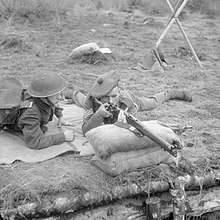Mad minute

_-_UK_-_cal_303_British_-_Arm%C3%A9museum.jpg)
The Mad Minute was a pre-World War I bolt-rifle speed shooting exercise used by British Army riflemen, using the Lee–Enfield service rifle. The exercise formally known as "Practice number 22, Rapid Fire, ‘The Musketry Regulations, Part I, 1909", required the rifleman to fire 15 rounds at a "Second Class Figure" target at 300 yd (270 m). The practice was described as; "Lying. Rifle to be loaded and 4 rounds in the magazine before the target appears. Loading to be from the pouch or bandolier by 5 rounds afterwards. One minute allowed". The practice was only one of the exercises from the annual classification shoot which was used to grade a soldier as a marksman, first-class or second-class shot, depending on the scores he had achieved. The rapid aimed fire of the ‘Mad Minute’ was accomplished by used a 'palming' method where the rifleman used the palm of his hand to work the bolt, and not his thumb and forefinger, while maintaining his cheek weld and line of sight.
The "Second Class Figure Target" was 48 inches square (approximately 1.2 x 1.2 meters), with 24 in (61 cm) inner and 36 in (91 cm) magpie circles. The aiming mark was a 12 in × 12 in (30 cm × 30 cm) silhouette figure that represented the outline of the head of a man aiming a rifle from a trench. Points were scored by a hit anywhere on the target.
World record

The first Mad Minute record was set by Sergeant Major Jesse Wallingford in 1908, scoring 36 hits on a 48 inch target at 300 yards (4.5 mils/ 15.3 moa).[1] Another world record of 38 hits, all within the 24 inch target at 300 yards (2.25 mils/ 7.6 moa), is said to have been set in 1914 by Sergeant Instructor Alfred Snoxall,[2]

A Mad Minute event was held in Soknedal, Norway, on 30 May 2015 featuring some of the best stang shooters in the country.[3] The competition was called the "Mad Minute Challenge"[4], and was shot at a round 400 mm diameter target at 200 meters (2 mils/ 6.9 moa), making the target smaller than original. The winner, Thomas Høgåsseter, scored 36 hits. The average score, of 11 shooters, was 29.
Target section sizes
The tables below are based on the sections (12, 24, 36 and 48 inches) of the original Second Class Figure target placed at 300 yards, and shows the same relative target sizes for different ranges. The military service ammunition from that time (such as .303 British, .30-06 Springfield, 6.5×55mm, 8x57mm etc.) were more high powered and less prone to suffer from wind drift compared to modern military intermediate cartridge (such as 5.56 NATO, 5.45×39mm, 5.8×42mm, etc.). With the high powered calibers wind drift will barely be noticeable at 100 m, slightly more at 200 m and will only become a small factor at 300 m.
- Equivalent imperial target sizes
| Relative size | 100 yd (91 m) | 200 yd (183 m) | 300 yd (270 m) |
|---|---|---|---|
| 3.82 moa (1.11 mil) | 4 in (100 mm) | 8 in (203 mm) | 12 in (305 mm) |
| 6.75 moa (2 mil) | 7 in (180 mm) | 14 in (355 mm) | 21 in (530 mm) |
| 7.64 moa (2.22 mil) | 8 in (203 mm) | 16 in (406 mm) | 24 in (610 mm) |
| 11.46 moa (3.34 mil) | 12 in (305 mm) | 24 in (610 mm) | 36 in (914 mm) |
| 15.3 moa (4.5 mil) | 16 in (410 mm) | 32 in (810 mm) | 48 in (1220 mm) |
- Equivalent metric target sizes
| Relative size | 100 m | 200 m | 300 m | Explanation |
|---|---|---|---|---|
| 1.11 mil (3.82 moa) | 111 mm | 222 mm | 333 mm | Size of aiming mark of the Second Class Figure |
| 2 mil (6.75 moa) | 200 mm | 400 mm | 600 mm | Target size used in the modern Mad Minute Challenge, scoring only 1 point per hit (2015 record of 36 hits) |
| 2.22 mil (7.64 moa) | 222 mm | 444 mm | 666 mm | Inner ring of the Second Class Figure (3 points), sizes equivalent to the story of Alfred Snoxall 38 hits |
| 3.34 mil (11.46 moa) | 334 mm | 668 mm | 1000 mm | Outer ring of the Second Class Figure (2 points) |
| 4.5 mil (15.3 moa) | 450 mm | 900 mm | 1350 mm | Outer square of the Second Class Figure (1 point) |
See also
Notes
References
- ↑ Historical Firearms - The Mad Minute
- ↑ Ian V. Hogg, The Encyclopedia of Weaponry, Sterling Publishing, New York 2006.
- ↑ Soknedal Skytterlag - Norgescup stang og felthurtig 2015 Archived 2016-03-04 at the Wayback Machine.
- ↑
- Holmes, Richard, "From Musket to Breech Loader", History Trails, BBC